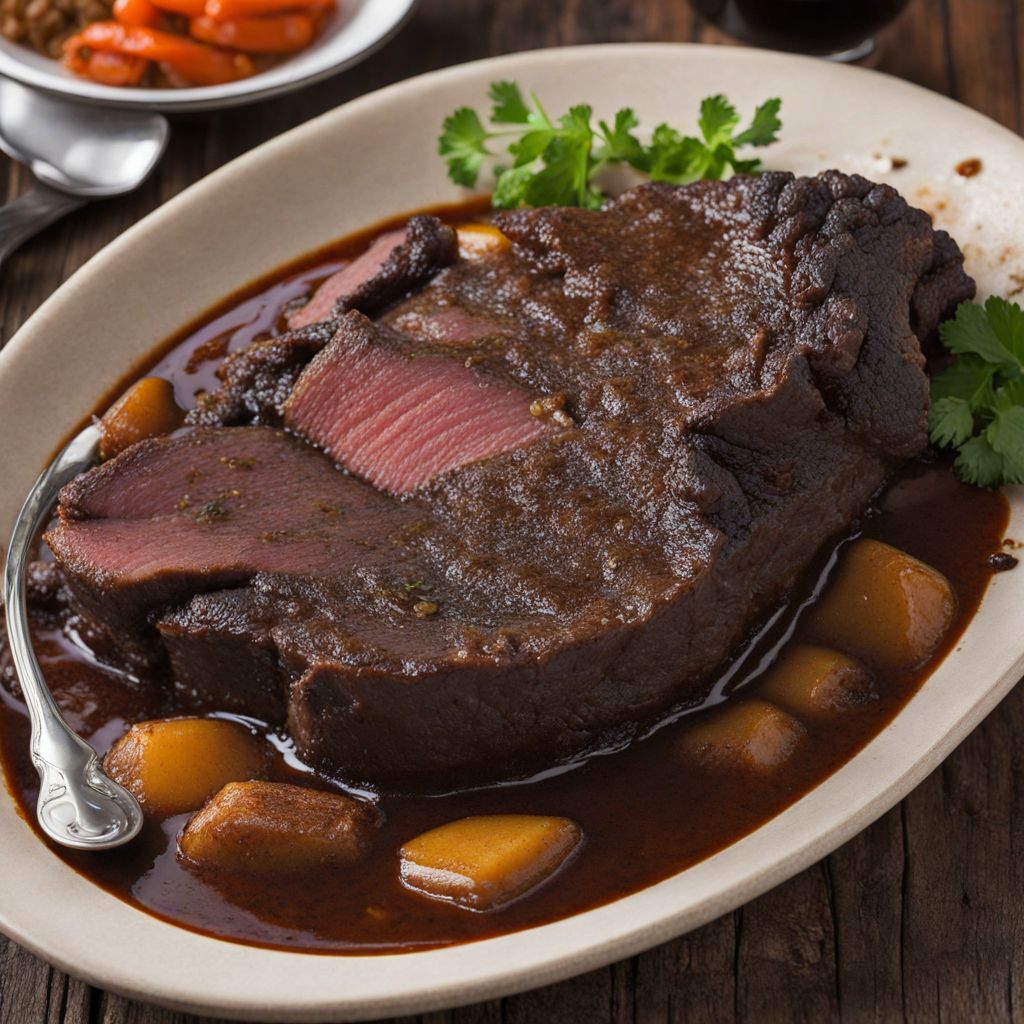Asopado
Asopado is a beloved Venezuelan dish that combines the heartiness of a stew with the comforting qualities of a rice dish. At its core, Asopado features tender pieces of meat, often chicken or seafood, simmered with a rich, flavorful broth. The dish is characterized by its unique blend of spices, which may include garlic, cumin, and a touch of saffron for warmth and color. The rice is cooked directly in the broth, allowing it to absorb all the savory flavors, resulting in a deliciously creamy texture that is both satisfying and filling. One of the standout elements of Asopado is its versatility. Each region of Venezuela has its own variation, with local ingredients and personal touches that make it special. Some versions might incorporate fresh vegetables like bell peppers, tomatoes, or peas, while others may feature a medley of seafood such as shrimp and fish, creating a delightful ocean-inspired flavor profile. The dish is often garnished with fresh herbs, adding a pop of color and a burst of freshness that perfectly complements the richness of the stew. Asopado is more than just a meal; it is a social dish often prepared for gatherings and celebrations. The communal aspect of serving a large pot of Asopado invites family and friends to share in the experience, making it a perfect comfort food that brings people together. The combination of aromatic spices, tender meat, and creamy rice creates a harmonious blend of flavors that will tantalize your taste buds and leave you craving more. Discovering Asopado is not just about tasting a new dish; it is an invitation to embrace Venezuelan culture and its culinary traditions.
How It Became This Dish
The Rich Tapestry of Asopado: A Venezuelan Culinary Delight Asopado, a hearty and fragrant dish that embodies the culinary spirit of Venezuela, is more than just a meal; it is a celebration of heritage, community, and the natural bounty of the land. This dish, often made with rice, various meats, and a medley of vegetables, reflects the diverse influences that have shaped Venezuelan cuisine over the centuries. To understand asopado, one must delve into its origins, cultural significance, and the evolution it has undergone throughout history. #### Origins: A Confluence of Cultures The roots of asopado can be traced back to the indigenous peoples of Venezuela, who used local ingredients to create nourishing meals. The word "asopado" itself is derived from "sopa," meaning soup, which hints at its soupy, stew-like consistency. The indigenous populations, particularly the Arawaks and Caribs, relied on ingredients such as cassava, fish, and various meats, laying the groundwork for the flavors that would later characterize Venezuelan cuisine. With the arrival of Spanish colonizers in the 16th century, the culinary landscape began to transform dramatically. The Spanish brought with them a variety of ingredients, including rice, which has become a staple in many Venezuelan dishes. The combination of indigenous techniques and Spanish ingredients paved the way for the creation of asopado. The Spanish influence introduced flavors such as saffron and paprika, which are often found in contemporary recipes of asopado, enhancing its complexity and richness. #### Cultural Significance: A Dish of Community and Tradition Asopado is more than just a comfort food; it is a dish that embodies the communal spirit of Venezuelan culture. Traditionally, it is prepared for gatherings, celebrations, and special occasions, reflecting the importance of family and friendship in Venezuelan society. The preparation of asopado often becomes a social event, with family members coming together to chop, stir, and share stories as they cook. Venezuelans take great pride in their culinary traditions, and asopado is often a centerpiece during festive occasions, such as Christmas and New Year celebrations. The dish is versatile and can vary significantly from region to region. For instance, in coastal areas, seafood versions of asopado, featuring shrimp or fish, are common, while in the interior regions, beef or chicken might be the primary protein. This adaptability showcases the local ingredients available and the creativity of the cooks, making each version of asopado unique in its own right. The dish also serves as a link between generations, with recipes often passed down from grandparents to parents and then to children. This transmission of culinary knowledge helps preserve cultural identity and fosters a sense of belonging in a rapidly changing world. #### The Evolution Over Time While asopado has remained a beloved dish throughout Venezuelan history, its preparation and ingredients have evolved to reflect changing tastes, societal influences, and economic conditions. In the early 20th century, as the country experienced significant social and economic changes, the availability of ingredients impacted how asopado was made. The rise of urbanization led to a greater reliance on convenience foods and processed ingredients, which began to seep into traditional recipes. In contemporary Venezuela, asopado represents both tradition and innovation. While many still adhere to the classic recipes, modern cooks have begun to experiment with flavors and techniques. Fusion cuisine has entered the scene, with chefs incorporating international flavors or alternative ingredients to cater to a more diverse palate. For example, some may add spices from Asian cuisine or utilize quinoa instead of rice, a nod to the global food trends that have taken root in Venezuela. Moreover, the political and economic turmoil that Venezuela has faced in the past decade has had a profound impact on the way asopado is made. With food shortages and inflation affecting the availability of traditional ingredients, families have had to adapt their recipes, often using whatever is accessible. This has led to a resurgence in creativity, as cooks find ways to make asopado with limited resources, showcasing the resilience and ingenuity of the Venezuelan people. #### Asopado in the Global Arena In recent years, asopado has started to gain recognition beyond Venezuela's borders. Venezuelan expatriates and culinary enthusiasts have introduced the dish to international audiences, often presenting it at food festivals or cultural events. Such exposure has sparked interest in Venezuelan cuisine as a whole, highlighting the rich flavors and cultural narratives that accompany dishes like asopado. Social media has played a crucial role in this culinary promotion. Food bloggers, chefs, and home cooks alike share their takes on asopado, complete with enticing imagery and personal stories, making it a dish that resonates with many. This digital presence has fostered a sense of community among Venezuelans abroad, who use asopado as a way to connect with their roots and share their culture with others. #### Conclusion: A Legacy of Flavor and Culture Asopado stands as a testament to Venezuela's rich culinary heritage, encapsulating the history, culture, and resilience of its people. From its indigenous origins to its contemporary interpretations, asopado reflects the blending of cultures and the adaptation of traditional recipes to modern life. It is a dish that brings people together, celebrating the ties of family and community while offering a taste of Venezuela's vibrant history. In every bowl of asopado, there is a story waiting to be told—stories of the land, of the people, and of the enduring spirit that has shaped this beloved dish. As Venezuela continues to navigate its challenges, asopado will undoubtedly remain a symbol of hope, unity, and the rich tapestry of flavors that define Venezuelan cuisine.
You may like
Discover local flavors from Venezuela







